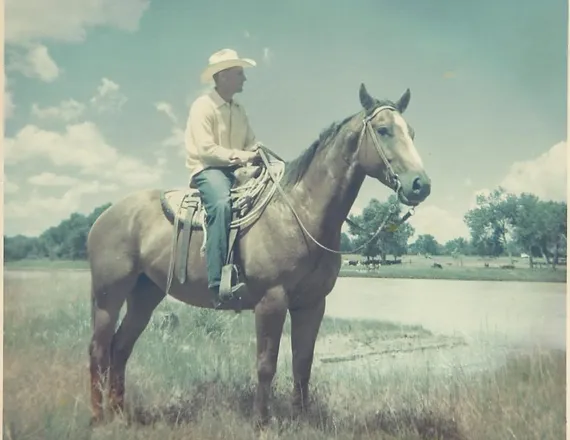William (Bill) Shaw Gray was born July 25, 1927 on a ranch near Orin Junction, Wyoming where he began his cowboy legacy. Being the eldest of three boys, with brothers Bob and Corky, he grew up working with his Mother, Patty “Shaw” Gray, Father, Bill Gray and his two uncles Roscoe (Peach) Shaw and Clay Shaw, raising cattle, horses, and putting up hay. He later graduated from Douglas High School in 1945 and attended the University of Wyoming for approximately a year.
The ranch where Bill worked all his life was originally started by Bill’s Grandfather James Clay Shaw who brought trail herds from Texas in 1878. The cattle were taken to Ogallala, Nebraska where they were split. The big steers were shipped to South Dakota and the breeding stock was taken back to Wyoming. This is where James settled down on the Platte River near Orin. When James C. Shaw later became the president of the Wyoming Stock Growers, it was said he was a Cowboys cowboy. His lasting family cowboy heritage was unquestionably passed down to his kids and grandkids including Bill.
As a kid, Bill recalls working for Ed McCarty and Vern Elliot at Cheyenne frontier days in the late 1930’s and all through the 40’s. Bill worked alongside his brothers and cousins helping with the rough stock events and participating in the wild horse race which he won a couple times. Shortly thereafter, Bill was drafted on July 17, 1951. While Bill was serving in Korea his younger brother, Corky, was killed in an automobile accident. After his time spent in Korea, Bill returned to the ranch where he worked for his Uncle Clay. They put up hay, raised horses, and had about 200 head of cows. During this time, sale barns did not exist. All cattle were sold on the rail road and shipped to either Omaha or Rapid City. There was no place to weigh the cattle that were sold. They would be loaded on a train and shipped 600 odd miles before they were weighed. Bill says in his lifetime the two best things for the cattle industry in Converse County were Doc Smiley as a veterinarian and getting a sale barn.
In his younger days, he also recollects having a steady number of 5 stud bunches with 30 mares each. The colt crop averaged around 100 foals a year. “You could get on a fresh horse every hour all day long. You learned to stay a little longer when one was buckin’ after you had to walk 5 miles back to the house”. Bill also remembers long hours in the hay field. “When it came time to irrigate, you were out there for an hour before daylight and spent nearly all day at it.”
On September 18, 1954, Bill Married Anne Willox. From 1955-1961 they worked for and raised cattle on the Willox ranch south of Douglas. They then returned to the home place where he inherited the XP brand and started Gray Ranch. He was not only a good horseman but also a good stockman who had a good eye for bulls and with his wife’s incredible memory of every cow, knew which ones to keep. They put all focus in the excellence of their cowherd by knowing each individual cow and culling deep; putting together the nicest set of Hereford cows anybody could ask for. With priorities on production and weaning weights, it would be hard to find any cattle rancher who cared about the quality of their herd more than Bill and Annie Gray did.
As the cattle herds around Converse County began transition over to Angus bulls, the Gray ranch was one of the last to do so. In the early 80’s, they started using Charolais bulls, which they still use today. This was the perfect mix with their admired cow herd. Bill says, “Those Charolaise cross calves will gain and grade”. Bill and Annie also raised race horses as a hobby where they had substantial success on the racetrack. They raised three kids of their own and have had a large impact on the lives of their grandkids. Bill and his wife Annie were so considerate of others. They were great at hosting large crowds or just sitting around the kitchen table telling stories.
As far as rodeo experience, he had plenty of that as well. Bill was quite a sticky bareback rider. Pete Burns once said Fred Hageman and Bill Gray were the first in the bareback riding to fall back and hook em’. He also remembers entering the Guernsey rodeo and winning the bull dogging event. “Those two steers were the first, last, and only steers I ever jumped.” Bill would have liked to extend his rodeo career but with a ranch to run, his priorities had to be elsewhere.
Without question, Bill Gray lived through times where you worked to make a living. He grew up around the best cowboys the country had ever seen. The foundation of the Wyoming cowboy heritage that stands today. He worked to survive and raise his family. He shared his knowledge and inspired people. He strived to enhance agriculture and uphold the cowboy way of life which we all hold dear. Through low cattle prices and droughts, he continued to live a legacy.


